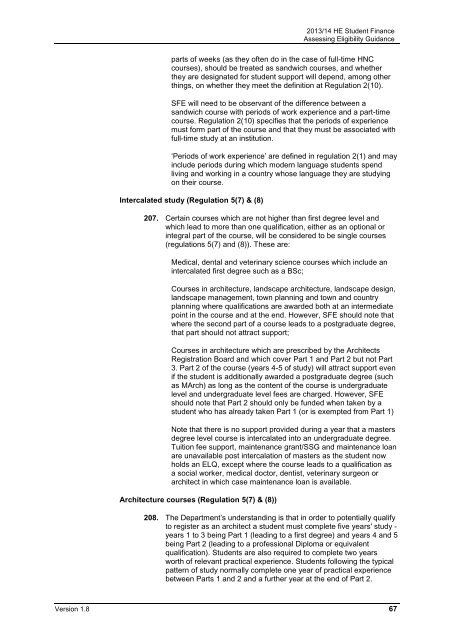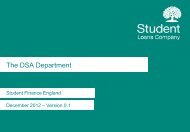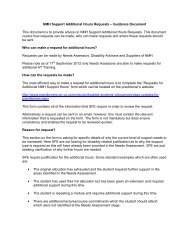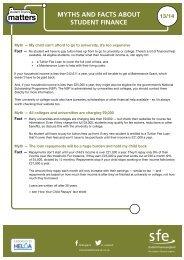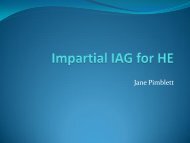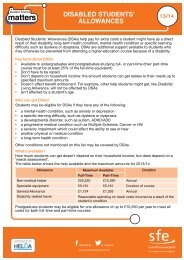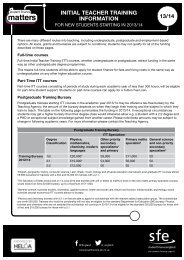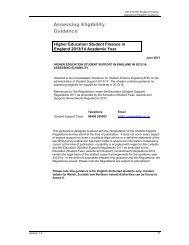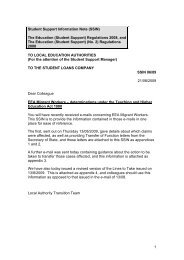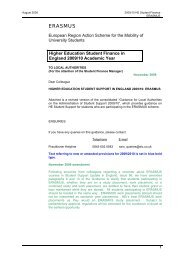SFE Assessing Eligibility Guidance 2013/14 - Practitioners - Student ...
SFE Assessing Eligibility Guidance 2013/14 - Practitioners - Student ...
SFE Assessing Eligibility Guidance 2013/14 - Practitioners - Student ...
You also want an ePaper? Increase the reach of your titles
YUMPU automatically turns print PDFs into web optimized ePapers that Google loves.
<strong>2013</strong>/<strong>14</strong> HE <strong>Student</strong> Finance<br />
<strong>Assessing</strong> <strong>Eligibility</strong> <strong>Guidance</strong><br />
parts of weeks (as they often do in the case of full-time HNC<br />
courses), should be treated as sandwich courses, and whether<br />
they are designated for student support will depend, among other<br />
things, on whether they meet the definition at Regulation 2(10).<br />
<strong>SFE</strong> will need to be observant of the difference between a<br />
sandwich course with periods of work experience and a part-time<br />
course. Regulation 2(10) specifies that the periods of experience<br />
must form part of the course and that they must be associated with<br />
full-time study at an institution.<br />
„Periods of work experience‟ are defined in regulation 2(1) and may<br />
include periods during which modern language students spend<br />
living and working in a country whose language they are studying<br />
on their course.<br />
Intercalated study (Regulation 5(7) & (8)<br />
207. Certain courses which are not higher than first degree level and<br />
which lead to more than one qualification, either as an optional or<br />
integral part of the course, will be considered to be single courses<br />
(regulations 5(7) and (8)). These are:<br />
Medical, dental and veterinary science courses which include an<br />
intercalated first degree such as a BSc;<br />
Courses in architecture, landscape architecture, landscape design,<br />
landscape management, town planning and town and country<br />
planning where qualifications are awarded both at an intermediate<br />
point in the course and at the end. However, <strong>SFE</strong> should note that<br />
where the second part of a course leads to a postgraduate degree,<br />
that part should not attract support;<br />
Courses in architecture which are prescribed by the Architects<br />
Registration Board and which cover Part 1 and Part 2 but not Part<br />
3. Part 2 of the course (years 4-5 of study) will attract support even<br />
if the student is additionally awarded a postgraduate degree (such<br />
as MArch) as long as the content of the course is undergraduate<br />
level and undergraduate level fees are charged. However, <strong>SFE</strong><br />
should note that Part 2 should only be funded when taken by a<br />
student who has already taken Part 1 (or is exempted from Part 1)<br />
Note that there is no support provided during a year that a masters<br />
degree level course is intercalated into an undergraduate degree.<br />
Tuition fee support, maintenance grant/SSG and maintenance loan<br />
are unavailable post intercalation of masters as the student now<br />
holds an ELQ, except where the course leads to a qualification as<br />
a social worker, medical doctor, dentist, veterinary surgeon or<br />
architect in which case maintenance loan is available.<br />
Architecture courses (Regulation 5(7) & (8))<br />
208. The Department‟s understanding is that in order to potentially qualify<br />
to register as an architect a student must complete five years' study -<br />
years 1 to 3 being Part 1 (leading to a first degree) and years 4 and 5<br />
being Part 2 (leading to a professional Diploma or equivalent<br />
qualification). <strong>Student</strong>s are also required to complete two years<br />
worth of relevant practical experience. <strong>Student</strong>s following the typical<br />
pattern of study normally complete one year of practical experience<br />
between Parts 1 and 2 and a further year at the end of Part 2.<br />
Version 1.8 67


